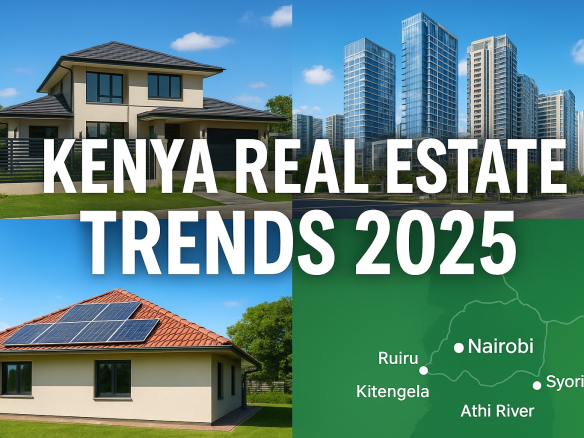**Introduction**
Nestled along the equator and renowned for its breathtaking landscapes, diverse wildlife, and vibrant cultures, Kenya is not just a haven for tourists; it is also emerging as a dynamic player in the global real estate market. As urbanization accelerates and developers innovate, the Kenyan real estate sector is transforming into a multifaceted arena marked by both challenges and opportunities. This article delves into the current dynamics of Kenya’s real estate landscape, uncovering trends, exploring investment prospects, and shedding light on the factors shaping the future of property ownership in this East African gem. Join us as we navigate through bustling urban centers, serene suburbs, and breathtaking coastal developments to understand what makes Kenya’s real estate scene a compelling frontier today.

Emerging Trends Shaping Kenya’s Real Estate Market
Kenya’s real estate market is undergoing significant conversion, driven by various emerging trends that are reshaping the landscape. One of the most impactful trends is the growing emphasis on **sustainability**. developers are increasingly incorporating eco-friendly designs, leveraging renewable energy sources, and using lasting materials to appeal to environmentally conscious buyers. This shift not only attracts a new demographic of homebuyers but also aligns with global standards for sustainable development. Moreover, as urbanization continues to escalate, there is a rising demand for **mixed-use developments** that combine residential, commercial, and recreational spaces, creating vibrant and self-sustaining communities.
Another noteworthy trend is the increasing use of **technology** in real estate transactions and property management. Virtual tours, 3D modeling, and online platforms for property listings are revolutionizing how buyers and sellers interact. Additionally, the adoption of **smart home technologies** is becoming commonplace, with developers integrating advanced security systems, energy-efficient appliances, and automation features in new properties. these innovations not only enhance the living experience but also contribute to the overall value of the properties. The combination of sustainable practices and technological advancements is not only influencing buyer preferences but is also setting a new benchmark for future developments in the Kenyan real estate market.

Urban Development: Opportunities in Major Cities
In the heart of Kenya’s bustling urban centers, a multitude of opportunities beckons to investors and entrepreneurs alike. The dynamic growth of cities such as Nairobi and Mombasa has fostered an ecosystem ripe for development, characterized by a mix of innovation and tradition. Property developers are exploring various avenues, including:
- Residential Projects: Increasing demand for affordable housing options to accommodate the growing middle class.
- Commercial Spaces: The rise of tech hubs and co-working spaces catering to start-ups.
- Infrastructure Development: Ongoing improvements in transport and utilities, enhancing connectivity.
Furthermore, the shift towards sustainable living is shaping the future of real estate in Kenya’s major cities. Investors are prioritizing green architecture and eco-friendly practices, which not only appeal to conscious consumers but also align with national goals for sustainability. To illustrate the emerging trends, the following table displays key sectors showing growth potential:
| Sector | Growth Rate (%) | Investment Opportunities |
|---|---|---|
| Residential Real Estate | 8-10 | Affordable housing, luxury apartments |
| Commercial Facilities | 12-15 | shared office spaces, retail centers |
| Green Buildings | 10-12 | Sustainable developments, renewable energy |

Sustainable Living: The Rise of eco-Friendly Properties
The adoption of eco-friendly properties is gaining significant momentum within Kenya’s real estate sector, reflecting a broader global trend towards sustainability. As urbanization accelerates and environmental concerns escalate, developers are increasingly integrating green practices into their projects. These properties not only minimize the carbon footprint but also provide numerous benefits to residents and investors alike. Some noteworthy features of sustainable properties include:
- Renewable Energy Sources: Many developments incorporate solar panels and wind turbines, significantly reducing reliance on non-renewable energy.
- Water Conservation: Eco-friendly homes often utilize rainwater harvesting systems and low-flow fixtures to promote efficient water use.
- Natural Materials: Sustainable construction focuses on using locally sourced, non-toxic materials to enhance both aesthetics and environmental impact.
- Green Spaces: Landscaping that emphasizes native plants contributes to biodiversity while providing residents with tranquil outdoor environments.
Investors are increasingly recognizing the long-term value of these eco-friendly developments. While they may carry a higher initial cost, properties designed with sustainability in mind often yield lower energy and maintenance expenses. Furthermore, they appeal to an expanding market of environmentally conscious buyers and tenants who prioritize green living. To illustrate this shift, the following table highlights key aspects of eco-friendly properties versus traditional ones:
| Feature | Eco-Friendly Properties | Traditional Properties |
|---|---|---|
| Energy Source | Primarily Renewable | Fossil Fuels |
| Water Usage | Low-flow Fixtures Rainwater Harvesting | Conventional |
| Building Materials | Recycled/Natural | Concrete/Steel |
| Overall Impact | Minimal Carbon Footprint | Higher Emissions |

Investment insights: Navigating Challenges and maximizing Returns
Kenya’s real estate market presents a unique blend of challenges and opportunities that require investors to be astute in their decision-making. The demand for housing continues to soar, driven by urbanization and a youthful population eager for quality living spaces. However, potential investors must navigate an array of factors that can impact their investments, including government regulations, land acquisition processes and infrastructural development. To capitalize on these market dynamics, it is indeed essential to stay informed about emerging trends. Key considerations include:
- Market Research: Conduct thorough analyses to understand regional demands and property values.
- Emerging Neighborhoods: Explore up-and-coming areas that offer promising growth potential.
- Sustainable Practices: Investing in eco-friendly developments can attract a diverse clientele and long-term value.
Additionally, leveraging technological advancements can provide a significant edge in this competitive landscape. The rise of PropTech, including property management software and virtual tours, enhances how properties are marketed and managed. investors can benefit from insightful data analytics that predict market trends and consumer preferences. Below is a brief overview of technological tools shaping the real estate sector in Kenya:
| Technology | Impact on Real Estate |
|---|---|
| Property Platforms | Increased visibility and accessibility for buyers and sellers. |
| Online Marketplaces | Streamlined buying process with clear pricing. |
| Smart Home tech | Enhanced property value through added convenience and efficiency. |
Closing Remarks
As we draw the curtain on our exploration of Kenya’s dynamic real estate landscape, it’s clear that the country’s property market is a vibrant tapestry woven from diverse threads of opportunity, resilience, and innovation. From the bustling urban centers like Nairobi and Mombasa to the serene landscapes of the countryside, each region tells a unique story of growth and transformation. Investors and home seekers alike are finding new potentials amid changing trends, encouraged by emerging technologies, sustainable practices, and evolving consumer preferences. Whether you are a seasoned investor or a curious newcomer, the insights gleaned from this dynamic environment can guide informed decisions and inspire bold ventures. In this era of remarkable changes, one thing remains certain: Kenya’s real estate landscape is more than just a market; it is indeed a reflection of the country’s aspirations and its people’s dreams. As we look toward the future, the promise of this evolving landscape beckons, inviting all to partake in a journey shaped by ambition, creativity, and the enduring belief in the power of home. So, whether you’re mapping your next investment or simply contemplating a move, remember that in Kenya’s real estate, the possibilities are as expansive as the horizon itself.




Join The Discussion